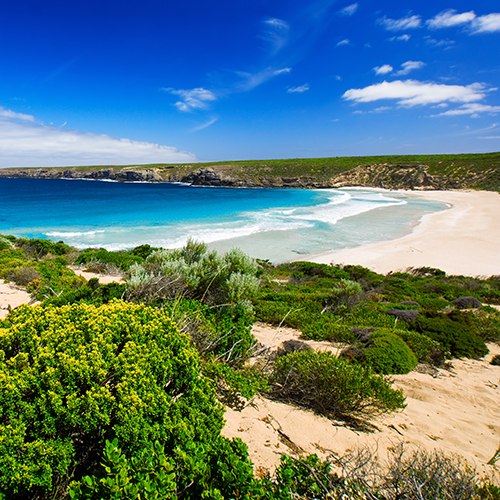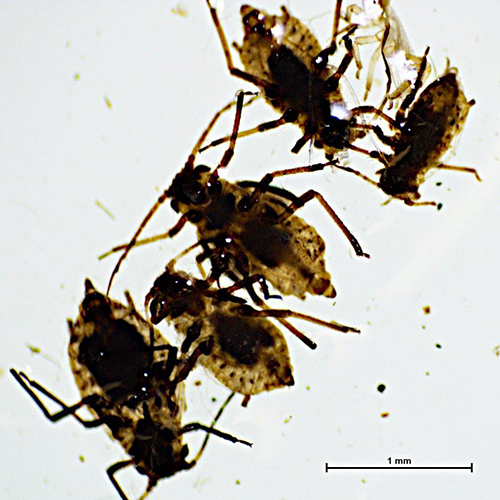01 July 2021
 An invasive species of aphid could put some threatened plant species on Kangaroo Island at risk as researchers from the University of South Australia confirm Australia’s first sighting of Aphis lugentis on the Island’s Dudley Peninsula.
An invasive species of aphid could put some threatened plant species on Kangaroo Island at risk as researchers from the University of South Australia confirm Australia’s first sighting of Aphis lugentis on the Island’s Dudley Peninsula.
It is another blow for Kangaroo Island’s environment, especially following the Black Summer bushfires that decimated more than half the island and 96 per cent of Flinders Chase National Park.
Collected by wildlife ecologist Associate Professor Topa Petit and identified by colleagues from the WA Department of Primary Industries and Regional Development, the black aphids were found feeding on seedlings of Senecio odoratus, a native species of daisy, commonly known as the scented groundsel.
Of 16 native Senecio species on the island, at least ten are of conservation concern.
Originating from North America, the sap-sucking black aphids have spread across multiple continents over the past 20 years. This first record of the pest in Australia.
Assoc Prof Petit says the alien aphid species could threaten plants in the Compositae (daisy) family.
“Aphids were tended by several species of native ants that were feeding on their honeydew, showing easy integration for the pest in its new environment,” Dr Petit says.
“The presence of Aphis lugentis on Kangaroo Island could have serious consequences on seedling survival of Senecio and related species – as well as unknown ones for native ant communities.”
Currently, 1,257 of Australia’s threatened and endangered species are directly affected by 207 invasive plants, 57 animals and three pathogens. The most recent estimates found the cost of controlling invasive species and economic losses to farmers in 2011-12 was A$13.6 billion.

Once established across Australia, invasive species can be very difficult to eradicate.
Entomology diagnostician, Cameron Brumley from the Department of Primary Industries and Regional Development in Western Australia, and geneticists Monica Kehoe and Cuiping Wang, examined the aphid and found matching DNA in a collection from Hurstville, NSW, indicating the greater spread of aphid across Australia. Authorities have been alerted.
“It is still unclear how some fragile species of Kangaroo Island are coping following last year’s bushfires, so I recommend that attention be paid to aphids present on plants related to daisies, on the island, but also on the mainland considering the likely presence of the aphid in other states. Its distribution needs to be mapped,” Dr Petit says.
“This aphid was probably introduced to Australia on ornamental plants. Locally native plants and native gardens offer better habitats for native wildlife and lower invasion risks. We need to learn to appreciate our remarkable native flora.”
…………………………………………………………………………………………………………………………
Notes to editors:
Australia has a long history of invasive species, with more than 3000 species introduced to Australia since 1770. Some of the most notorious examples of invasive species include:
- The CANE TOAD - Introduced to Australia in the 1930s as a biological control for sugar cane beetles, its population has grown from 102 to more than 200 million, wreaking havoc on the Australian ecosystem at a rate of 50km every year.
- PATERSON’S CURSE (or Salvation Jane) - This purple-flowering plant was introduced to Australian gardens in the 1880s, but quickly became a rampant weed. Now a target for biological control, it costs the Australian economy more than $250 million annually through lost productivity in pastures, control costs, and wool contamination.
- European rabbits – Introduced for hunting and food in the 1850s, Australia’s new rabbit population exploded, destroying crops, native flora, and land. Biological controls including the Myxoma Virus and the Rabbit Hemorrhagic Disease Virus have helped control populations.
- RED FIRE ANTS – Native to South America, these are highly invasive, aggressive ants that have a venomous and repetitive sting that can cause painful pustules, and anaphylaxis. The Federal Government now has a ten-year, $411 million plan to eradicate red fire ants from Southeast Queensland.
………………………………………………………………………………………………………………………
Media contact: Annabel Mansfield T: +61 8 8302 0351 M: +61 417 717 504
E: Annabel.Mansfield@unisa.edu.au
Researcher: Assoc Prof S. “Topa” Petit T: +61 8 8302 5194 E: Sophie.Petit@unisa.edu.au


